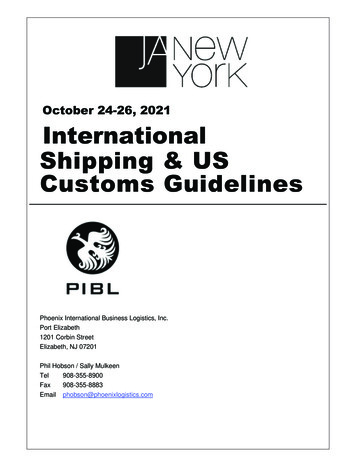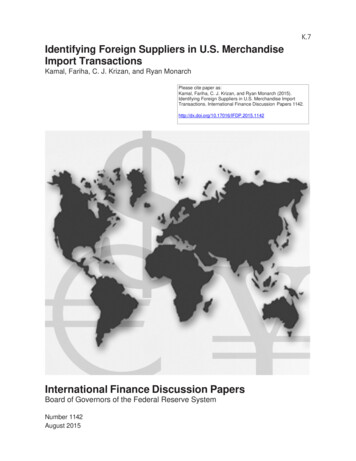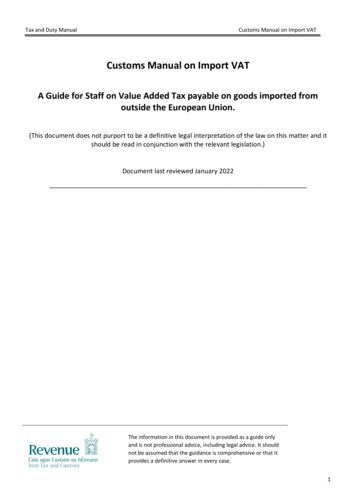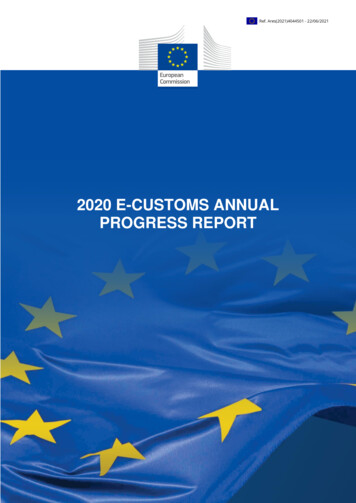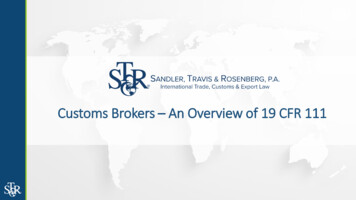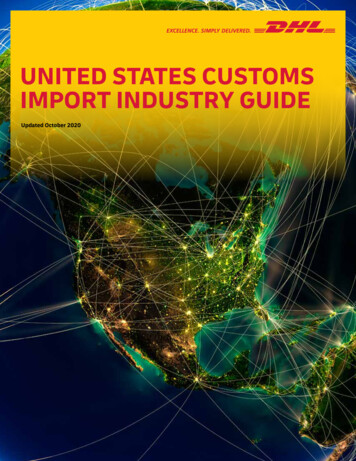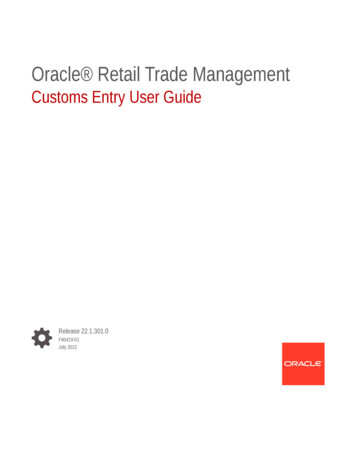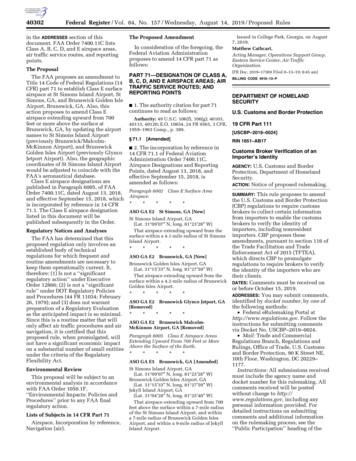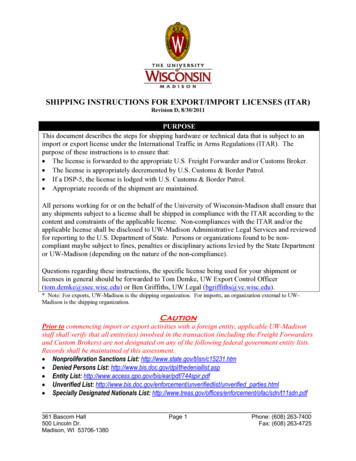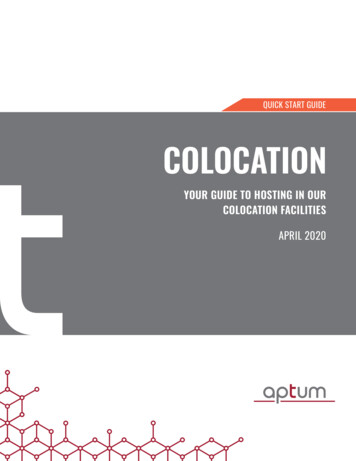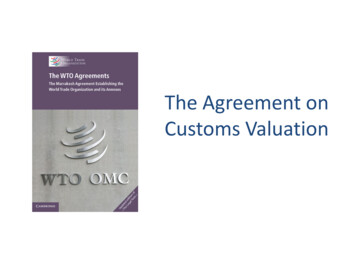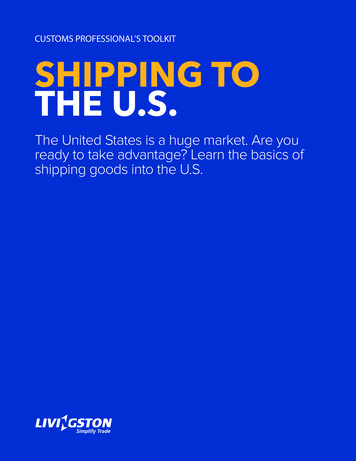
Transcription
CUSTOMS PROFESSIONAL’S TOOLKITSHIPPING TOTHE U.S.The United States is a huge market. Are youready to take advantage? Learn the basics ofshipping goods into the U.S.
Customs professional’s toolkitShipping to the U.S.The United States is a huge market. Areyou ready to take advantage? Learn thebasics of shippings goods into the U.S.Canada’s closest neighbor represents a land of opportunity for Canadian businesses looking to expand their customer base.But despite the long history and friendly relations between these countries, there are customs regulations and security measures inegulations is critical to your success when shipping to the U.S.The Customs Professional’s Toolkit: Shipping to the U.S. provides the basic information you need to get your goods clearedTable of contentsCommon U.S. shipping acronyms. . . . . . . . . . . . . . . . . . . . . . . . . . . . . . . . . . . . . . . . . . 3Learn to speak the language when shipping to the U.S.Understanding the key players . . . . . . . . . . . . . . . . . . . . . . . . . . . . . . . . . . . . . . . . . . . . 7Learn the roles and responsibilities of the key players in the shipping process.Key customs documents. . . . . . . . . . . . . . . . . . . . . . . . . . . . . . . . . . . . . . . . . . . . . . . . . 10An overview of the documents you need to export your goods to the U.S.Preparing your customs documents for shipping . . . . . . . . . . . . . . . . . . . . . . . . . . . 13A handy checklist of required Customs documents.Understanding customs clearance . . . . . . . . . . . . . . . . . . . . . . . . . . . . . . . . . . . . . . . . 15The four critical parts of the customs clearance process you need to understand.Overview of the release process . . . . . . . . . . . . . . . . . . . . . . . . . . . . . . . . . . . . . . . . . . 18Learn about the release of goods into the U.S., from documentation to methods.Overview of the entry summary . . . . . . . . . . . . . . . . . . . . . . . . . . . . . . . . . . . . . . . . . . 21Learn how to ensure your entry summary is complete and accurate.
SHIPPINGCOMMON U.S.SHIPPINGACRONYMSLearn the common U.S. shippingterms all importers and exportersshould know.
ShippingDefinitions of common U.S. shipping acronymsThe following list will assist you in understanding the meanings of many common shipping acronyms.ABI – Automated Broker InterfaceA system to submit electronic entry and release data to CBP.ACE – Automated CommercialEnvironmentThe commercial trade processing system being developedby CBP to facilitate legitimate trade and strengthen bordersecurity. (Implemented in multiple release phases with fullcompletion schedule for 2015).ACH – Automated Clearing HouseAn automated payment process for debit or credit.ACS – Automated Commercial SystemCBP’s current automation system. To be replaced by ACE.AES – Automated Export SystemA system that automates export reporting from the U.S.AMS – Automated Manifest SystemA systems that automates manifest reporting into the U.S.APHIS – Animal and Plant HealthInspection ServiceA agency with a mission to protect and promote U.S.agricultural health, regulate genetically engineeredorganisms, administer the Animal Welfare Act, and carry outwildlife damage management activities.BCS – Border Cargo SelectivityA system that assesses the risk and examinationrequirements for high volume borders.BRASS – Border Release AdvancedScreening and SelectivityFormerly known as line release; the process of releasinggoods (typically rail shipments) across the border. CBP preapproves products and a bar code label is used to effectrelease.CAFES – Customs Automated FormsEntry SystemA reporting system to CBP about shipments traveling underCBP – U.S. Customs and BorderProtectionThe bureau within the U.S. Department of Homelanda carrier’s bond for clearance or exportation at another port.Security that includes the border patrol, customs service,and inspectors at U.S. points of entry.C-TPAT – Customs Trade PartnershipAgainst TerrorismA voluntary supply chain security program led by CBPfocused on improving the security of private companies’supply chains with respect to terrorism.DOT – Department of TransportA federal cabinet department of the U.S. governmentdedicated to ensuring a fast, safe, efficient, accessible andconvenient transportation system.ESAR – Entry Summary, Accountsand RevenueESAR capabilities integrate and enhance ACE’s automatedentry summary processing. These ESAR features of ACEenable CBP and its trade partners to interact electronically.
FAST – Free and Secure TradeAn agreement between the U.S., Canada and Mexico onjoint border security initiatives.FCC – Federal CommunicationsCommissionAn independent U.S. government agency charged withregulating interstate and international communications byradio, television, wire, satellite and cable.FDA – Food and Drug AdministrationAn agency within the U.S. Public Health Service that assuresthe safety, efficacy, and security of human and veterinarydrugs, biological products, medical devices, the nation’sfood supply, cosmetics, and products that emit radiation.FTZ – Foreign Trade ZonesSpecified areas with favorable regulations for bordertrading.HMF – Harbor Maintenance FeeA CBP fee applied to all ocean shipments arriving in the U.S.ISA – Importer Self AssessmentA voluntary program where participants review theircompliance and report to CBP periodically on findingsso they do not undergo a Customs audits (focusedassessments).ISF - Importer Security FilingThe process of reporting 10 data elements to U.S. Customsfor shipments bound to a U.S. port. Importer Security Filingis required to comply with the new U.S. 10 2 regulations.MPF – Merchandise Processing FeeA fee collected by CBP on most goods imported into theU.S. that do not qualify for any special programs such asNAFTA.
PAPS – Pre-arrival Processing SystemThe mandatory release process for truck importations. Thisrelies on pre-filing the entry information with CBP for themto perform a risk assessment prior to arrival.PGA – Participating Government AgencyAny government agencies involved in the importprocess, such as the Food and Drug Administration, theEnvironmental Protection Agency, and the Department ofTransportation.PMS – Periodic Monthly StatementA process where an importer/customs broker makespayments of duty on a monthly basis rather than an entry byentry basis.RLF – Remote Location FilingA process that allows approved customs brokers orimporters to submit electronic entry data for clearance froma location other than the port of arrival.SCAC – Standard Carrier Alpha CodeA code issued by the National Motor Freight TrafficAssociation (NMFTA). It is a is a unique identifier for thecarrier.SCN – Shipment Control NumberA unique number identifying a shipment. It can be thePRO number, PAPS number or another form of master billnumber.USDA – U.S. Department of AgricultureThe department responsible for developing and executingU.S. federal government policies on farming, agriculture andfood.Contact Livingston Have questions or need help with your shipments? Contact your account executive, write to us at:simplify@livingstonintl.com or give us a call at 1-800-837-1063www.livingstonintl.com
IMPORTING AND EXPORTINGSHIPPINGTO THE U.S.UNDERSTANDINGTHE KEY PLAYERSLearn the roles and responsibilitiesof key players in the shipping process.
Importing and ExportingShipping to the U.S.Roles andresponsibilities ofkey playersAs the exporter, when you ship to the U.S., you must relyon others in the supply chain to fulfill their responsibilities inorder for your goods to clear Customs. To avoid unpleasantsurprises, it pays to know what your partners’ roles involve,and what you are responsible (and liable) for.ImporterThe importer is responsible for everything that’s declaredand filed with U.S. Customs. As such, the importer shouldobtain all necessary information regarding the shipment/product(s) from you, as the exporter usually has the bestknowledge of the product.The importer must fulfill the following responsibilities: Pay all duties and taxes to U.S. CustomsProvide accurate information to U.S. CustomsMake available all necessary export and import permitsPay any fines or penalties resulting from missing orinaccurate information Keep records to substantiate what goods were importedinto the U.S., including quantities, prices paid, and theorigin of goods. These records must be kept in eitherpaper or electronic format for five years after the goodsentered the United StatesExporterThe exporter (in most cases the seller) arranges fortransportation of the goods and typically supplies the carrierwith customs documentation needed to send the goods tothe United States. The information required is conveyed ona standard U.S. Customs pro-forma invoice or a commercialinvoice.The documentation provided by the exporter must includethe following information: The name and address of the exporter The name and address of the producer, if different fromthe exporter The name, address, and Internal Revenue Service (IRS)number of the company where the shipment is to bedelivered (consignee/buyer) The name, address, and IRS number of the companypurchasing product(s), if different from the consignee/buyer The product/shipment information including completedescription, value, quantity and packing, weight, currencyof sale and country of origin Any extra documentation such as special permitsrequired by Participating Government Agencies (PGAs)CarrierLearn about the roles andresponsibilities of key playersin the process of exporting tothe U.S.The carrier transports the goods, and is responsible forreporting the shipment to U.S. Customs.When the shipment arrives at the Canada-U.S. border, thecarrier submits the documentation to U.S. Customs and theU.S. customs broker.
Customs brokerThe customs broker is a company or individual licensed byU.S. Customs to act as an intermediary between the U.S.government and the importer. The importer has to provideCustoms with a legal document called the U.S. Power ofAttorney, authorizing the broker to act as the agent.Customs brokers are responsible for keeping up-to-date onnew regulations that may affect the importer, and deal withother customs-related issues, so the importer can focus ontheir core business.Customs brokers provide the following services: Prepare and present the necessary customs releasedocuments or data required by Customs and PGAs Facilitate the release of goods from U.S. Customs custody File entry (CF 7501) data/documents with U.S. Customs onbehalf of the importer Pay duties on behalf of the importer Pay carrier charges on behalf of the importer The right to deny access, search, seize or requestadditional information on all goods imported into theUnited States Profile maintenance for all U.S. importers (residents andnon-residents). The profile impacts the importer’s ability toparticipate in special U.S. Customs initiatives designed toeither simplify or speed up Customs clearance Prevention of illegal trade practices, including provisionsrelated to quotas and the marking of importedmerchandise, the Anti-Dumping Act, patents andtrademarks Enforcement of import restrictions and prohibitions Accurate collection of import and export data forcompilation of international trade statistics.Confidence comes from knowingIn trade, confidence comes from knowing. When you knowwho is responsible for each piece of the importing puzzle,you can more effectively deal with problems should theyarise.U.S. Customs and Border ProtectionU.S. Customs, also known as Customs and Border Protection(CBP) is the government body that controls cross-bordertrade into the United States.Contact Livingston Have questions or need help with yourAmong other responsibilities, U.S. Customs is tasked with thefollowing duties: Assessment and collection of customs duties, excisetaxes, fees and penalties due on imported merchandisewww.livingstonintl.comshipments? Contact your account executive,write to us at: simplify@livingstonintl.comor give us a call at 1-800-837-1063
IMPORTING AND EXPORTINGSHIPPINGTO THE U.S.KEY CUSTOMSDOCUMENTSLearn the U.S. customs documents youneed to familiarize yourself with to ensurefast, efficient clearance of your goods.
Importing and ExportingShipping to the U.S.The key U.S. Customsdocuments you needto knowClearing your goods for entry into the U.S. can bechallenging, but the process can become even morecomplicated if you neglect to include the properdocumentation with your shipment. Customs documentationincludes any documents required by U.S. Customs andParticipating Government Agencies (PGAs) to accuratelyidentify imported goods. The U.S., like every country, has itsspecific rules and regulations regarding the information anddocuments required from the trade community.The following is an overview of the documents you need tohave in order for your shipment to get where it needs to go.Standard documents needed with mostshipmentsU.S. Customs Invoice/Commercial InvoiceThe Customs Invoice (also referred to as the CommercialInvoice) is the basic document provided to the carrier. Itidentifies the exporter and importer, as well as the type andvalue of goods shipped.The U.S. Invoice requirements are: Adequate description and quantities of the goods being The name and complete address of the foreign individualor firm responsible for invoicing the goods.Note: This is typically the manufacturer/seller, but in theevent that the manufacturer is not the seller, the partywho sold the merchandise for export to the U.S. or madethe merchandise available for sale can be used. The parties involved in the importing process.shipped. Values (or approximate values) of the goods. The appropriate eight-digit subheading from theHarmonized Tariff Schedule of the United States.Used to determine the value of the goods, the document ispresented by the carrier to Customs officials once the goodsreach the border.Note: If the importer is uncertain of the appropriateThe Customs invoice serves a dual purpose for importsubheading number, Customs can offer assistance. Theshipments:port director may waive this requirement if satisfied that It enables the exporter to collect money from the importerthe information is not available at the time the goods areauthorized for release.based on the value of the goods; It helps the importer or their agent in clearing the goodsthrough Customs.An overview of the importantdocuments you will need to shipyour goods into the U.S.Inward Cargo ManifestAn Inward Cargo Manifest is an itemized list of a shipment’scontents. The manifest must be provided to officials forcustoms clearance either as a paper or electronic copy. Air,ocean, rail and U.S.-Canada border manifests are submitted
electronically. Electronic manifests are supported on theprepare the shipment. Although a packing list is not requiredU.S.-Mexico border, but form CF7533 is still used to supportby Customs, it is often used by customs brokers to obtainPGAs.helpful information about the shipment. A detailed packinglist will also be valuable should Customs request to do anThe carrier usually prepares the manifest based on theinspection.information provided by the shipper/exporter (the brokerhas its own identifier, called a Customs Manifest/In BondDocuments required in specialcircumstancesnumber. Once submitted and accepted by Customs, the FCC 740 – A Federal Communications Commissiondoes not always receive a copy of the manifest). A manifestmanifest and the number are monitored to ensure the properdocument required for devices that emit radioclearance and closure of a shipment.frequencies.Bill of LadingThe Bill of Lading (BOL) is a document issued to a shipper/exporter by a carrier describing the goods to be shipped,acknowledging their receipt, and stating the terms of thecontract for their carriage. The carrier provides a copy of theBOL to the exporter before departure, as evidence of the HS-7 – A Department of Transportation document,applicable to vehicles, tires and safety devices. EPA 3520-1 – An Environmental Protection Agencydocument, applicable to engines. PPQ 505 – A U.S. Department of Agriculture document,applicable for a Lacey Act declaration.transfer of goods from exporter to carrier. A copy of the BOLis also forwarded to the importer to arrange for the pickup ofthe goods. The third copy is kept for the carrier’s records.Packing listThe packing list is the detailed list of a shipment’s contents,including quantities, items, model numbers, dimensions,and net and gross weights. A packing list should specify percarton (or crate), the number/type of units of material inside,and is typically completed by the exporter at the time theywww.livingstonintl.comContact Livingston Have questions or need help with yourshipments? Contact your account executive,write to us at: simplify@livingstonintl.comor give us a call at 1-800-837-1063
ShippingPreparingyour customsdocumentsfor shippinginto THE U.S.Ensure smooth sailing when shippingto the U.S. with this helpful checklist
ShippingPreparing your customs documents forshipping into the U.S.Customs documents are the set of paperwork required by U.S. Customs and Border Protection to accurately and completely identifygoods that are being imported. The description, values and quantities you’re shipping will be recorded and reported to Customs.Documents for clearanceIf you’re shipping goods into the U.S., the checklist below will help you gather all the right documents that must accompanyeach shipment.Document*Issued byPARS Notification cover sheetExporter/CarrierExporterCustoms Invoice or Commercial Invoicee-Manifest or Cargo Control DepartmentBill of LadingOther Participating Government Agencies’ documents (PGA), if applicableCertificates of Origin (if goods are qualified)Shipper’s Export Declaration (if goods are deemed as controlled rter/Broker*Other documents may be required depending on the nature of the goods imported.Information you’ll need to complete the documentsName of U.S. customs broker, phone and faxBill to party/Importer of RecordsConsignee name, address and appropriate federal ID number (IRS number, Social Security number or Customs assigned number)Date of direct shipmentDescription of goods:Product/part number and descriptionCountry of originWhat material the product is made fromProduct useNumber of packages and weightClassification number (10-digit) – All goods that enter the U.S. are categorized according to the Harmonized TariffSchedule (HTS). Classification determines the rate of duty and any special requirements your product would be subject toupon import. Contact your broker for assistance with the classification of your goods.Conditions of sale/terms of payment/currencyShipment valueDeductions – value of goods only, not including packaging, freight or licensing charges, if applicableFreight charges/insuranceRestricted merchandise permits/licenses, if applicableFor more information on customs documentation or any other customs related inquiries, contact Livingston.Contact Livingston Have questions or need help with your shipments? Contact your account executive, write to us at:simplify@livingstonintl.com or give us a call at 1-800-837-1063www.livingstonintl.com
IMPORTING AND EXPORTINGSHIPPINGTO THE U.S.UNDERSTANDINGCUSTOMSCLEARANCEThe four critical parts of the customsclearance process you need to understand.
Importing and ExportingShipping to the U.S.Four parts of Customsclearance you needto understandHaving a solid understanding of U.S. Customs clearanceprocedures will help you deal with any issues that mightarise as your shipment travels across the border. Here’sa brief overview of the four most important parts of theclearance process:1Customs entryWhen a shipment arrives at the border, thecarrier must present the customs agents with the properdocumentation so that the goods can legally enter theUnited States.Customs entry is the process of presenting documentation– such as a Customs invoice, an Inward Cargo Manifest, aFind out more about the processyour goods go through whenentering the United States.Bill of Lading, and any other required documentation – toCustoms officials.Only the purchaser or licensed customs broker may submitthe goods for entry at the border.Imported merchandise not entered through Customs withinfive calendar days of arrival is sent to a general orderwarehouse, where it is held as unclaimed. The importer is2InspectionOccasionally, Customs will decide to inspect aresponsible for paying storage charges while unclaimedshipment once it arrives at a port of entry. U.S. Customsmerchandise is held at a warehouse. The merchandise ishas the right to search and seize all goods importedsold at auction or destroyed after one year if the goodsinto the United States in order to confirm that the goodsremain unclaimed.are admissible and the shipper has been compliant withgovernment regulations.A two-part processThe examination of goods helps Customs agents toThe Customs entry is usually a The value of the goods for Customs purposes and theirtwo-part process: Release, which involves the physical releaseof goods across the border into the UnitedStates. Entry summary, which is the process ofreviewing the documentation and performingthe accounting of duties payable on thegoods to U.S. Customsdetermine the following information about the shipment:dutiable status Whether the shipment contains prohibited articles Whether the requirements of other federal agencies havebeen met Whether the amount of goods listed on the invoice iscorrect, and no shortage or overage exists Country of origin
4An incorrect classification couldmean retroactive duties or seriouspenalties.LiquidationLiquidation is the last step in the entry process.Customs regulations define liquidation as the finalcomputation of duties on entries for consumption, or onthose entries entitled to duty drawback. When U.S. Customsis satisfied with the standing of the entry, and the dutieshave been paid, they ascertain how much of the duty paidby the importer should be returned. Usually, the formal entry3Appraisal and classificationTo determine the correct duty payable on goods, U.S.Customs will perform an appraisal of the shipment. Appraisalis liquidated within 314 days of entry filing. Some entries areliquidated earlier. For instance, informal entries valued at lessthan 2,000 are liquidated within 10 days of the release.is the process of determining the taxes owed to the U.S.government based on the Harmonized Tariff Schedule (HTS)of the United States.All goods entering the United States must be properlyclassified by the importer to ensure the appropriate HScode is assigned to the shipment. An importer should takepains to ensure the correct HS code is attached to his orher shipment to avoid paying extra when the shipment isexamined at the border. An incorrect classification couldmean retroactive duties or serious penalties.www.livingstonintl.comContact Livingston Have questions or need help with yourshipments? Contact your account executive,write to us at: simplify@livingstonintl.comor give us a call at 1-800-837-1063
Importing and ExportingShippingto the U.S.Overview ofthe releaseprocessLearn about the release of goods intothe U.S., from documentation to methods.
Importing and ExportingShipping to the U.S.Overview of therelease processLearn about the release of goods intothe U.S., from documentationto methods.Once your carrier picks up your goods, you may be temptedto sit back and forget about your shipment. But if you wantto be able to troubleshoot any problems that arise, youshould know what information to include with your shipment,and the different methods of releasing goods at the U.S.border. The release of goods is an authorization by U.S.Customs to deliver goods to the U.S. destination. Havingan understanding of which customs documents you needto include with your shipment and what information thosedocuments must cover will save you both time and money.Release information you need to haveMerchandise for which entry is required will be enteredwithin 15 calendar days after landing from a vessel, aircraft orvehicle; or after arrival at the port of destination in the caseof merchandise transported in bond. You or your customsbroker must file release documents to secure the physicalrelease of your goods from Customs and to allow them to beshipped to their destination in the U.S. The name, address, and IRS number of the companypurchasing the product(s), if it’s different than theconsignee; The product/shipment information including the completedescription, value, quantity and packing, weight, currencyof sale, and country of origin;Your release documentation must include thefollowing information: The name and address of the exporter; The name and address of the producer, if it’s differentfrom the exporter; The name, address, and the Internal Revenue Service Other information required by Participating GovernmentAgencies (PGAs), if applicable.Complete the correct documentsTo fulfill the information requirements for a customs release,there are a few essential documents you need to complete,including a Bill of Lading, a Packing List, a Cargo Manifest(IRS) number of the company where the shipment is to beand a Customs Invoice. However, if your goods are subjectdelivered (referred to as ultimate consignee or buyer);to PGA regulations, you may also be required to submitlicenses, or permits to satisfy those agencies.The Bill of Lading demonstrates that there is a legal contractLearn the basics of clearing yourgoods at the U.S. border.between the carrier and exporter to take the goods acrossthe border. A Cargo Manifest, prepared by the carrier, is acomprehensive list of the cargo being carried. The CustomsInvoice is a detailed description of the goods, including
the quantity and selling price, freight terms of delivery andpayment, insurance, packing costs, weight and volume. Thisdocument helps Customs to determine the duty on yourshipment.In lieu of the U.S. Customs Invoice the carrier can providethe required information by submitting one of the followingIf your goods are subject to PGAregulations, you may also berequired to submit licenses, orpermits to satisfy those agencies.documents or combination thereof: an airway bill, acommercial invoice, or packing lists.The importer may be required to provide additionaldocuments necessary to determine whether themerchandise may be admitted such as licenses, certificatesand permits.Your customs broker helps with the releaseThe customs broker performs the following actions to obtainContact Livingston the release of goods: Reviews the paperwork and contacts the relevant parties(importer, exporter, carrier, producer, etc.) to obtainmissing information or clarify inaccuracies; Submits a release package (usually electronic) toU.S. Customs.www.livingstonintl.comHave questions or need help with yourshipments? Contact your account executive,write to us at: simplify@livingstonintl.comor give us a call at 1-800-837-1063
Importing and ExportingShippingto the U.S.An overviewof the entrysummaryLearn how to ensure your entrysummary is complete and accurate.
Importing and ExportingShipping to the U.S.Completing andadjusting theentry summaryAn overview of the entrysummary processYour entry summary is one of the most important documentsyou will submit to Customs during the importing process.The documents in your entry summary package essentiallywork as a receipt for Customs to help agents determine theduty you owe. Therefore, ensuring that your entry summarydocumentation is accurate is crucial. Getting it wrong couldmean that you pay the wrong amount of duty, and incur heftypenalties as a result.Even when you take pains to make sure your documentationis accurate and complete, you might make a mistake. Thisoverview of entry summaries will also show you how tocorrect an error before Customs has the chance. Read on tolearn which type of entry summary you should file, and howto file properly to avoid fines.Informal (Consumption) entryInformal entries cover goods in personal shipments,Three types of entry summariesThere are three main types of entry summaries that you canfile depending on the type of goods you are shipping. Yourimported goods are not legally entered (registered) untilCustoms releases the goods, and you pay the estimatedduties and taxes. You or your broker must file an entrysummary (Customs form 7501), and pay duties within 10 daysof the date of release for your goods to be registered inthe U.S.commercial shipments and mail shipments that are broughtinto the U.S. for consumption (use or sale). In most cases, youcan submit an informal entry if the merchandise is valuedat US 2,500, or less. You can also submit an informal entrysummary if you are importing goods that you originallyexported from the U.S. with a value of less than US 10,000.Note that this only applies to imports for repairs or alteration,or imports rejected being returned for credit. This rule doesnot apply to goods re-sold.When you submit an entry summary for goods returned, U.S.Choosing the correct type of entry summary as it appliesCustoms allows for duty-free treatment. To qualify for thisto your shipment is crucial so that Customs can accuratelytype of informal entry summary, the goods must be in theassess how much duty you owe.same state as when they were first exported from the U.S.The goods must have been originally exported without thebenefit of duty drawback, as well.Learn how to complete an entrysummary form properly.Even if your shipment is valued at less than US 2,500, thereare some cases when an informal entry is not appropriate,including beef in certain tariff headings during certaincalendar periods.
Formal (Consum
Customs with a legal document called the U.S. Power of Attorney, authorizing the broker to act as the agent. Customs brokers are responsible for keeping up-to-date on new regulations that may affect the importer, and deal with other customs-related issues, so the importer can focus on their core business. Customs brokers provide the following .
